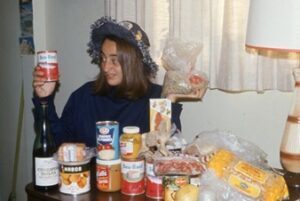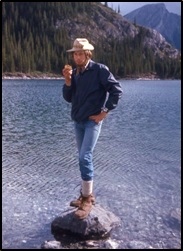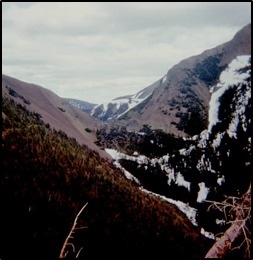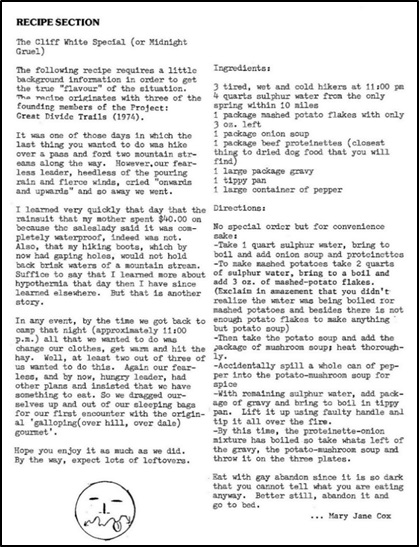by Jenny L. Feick, PhD, Editor of Tales from the Great Divide, Vignettes on the Origins & Early History of Canada’s Great Divide Trail and the Great Divide Trail Association
The questions that I get asked most often when GDTA volunteers find out I was one of the “original six” are ones related to the food and gear we used when we did the early trail surveys and route planning for the GDT between Waterton Lakes and Banff national parks. The topic of food came up quite a bit when we did the interviews that form the basis of Chapters Two to Six in Tales from the Great Divide.
For this issue of the Pathfinder, I’m sharing excerpts related to the food we ate in the summer of 1974 while doing the field work for Project: Great Divide Trails. Since our crew ranged in age from 19 to 23 and were backpacking or hiking around 25 miles per day in rugged terrain, we needed a lot of calories to sustain us. So, food was a top of mind concern then and in our recollections. While lighter weight backpacking food had come on the market by 1974, the budget limitations of our federal Opportunities for Youth grant precluded us purchasing such expensive products.
In the dialogue below, JENNY refers to Jenny Feick, MARY JANE to Mary Jane Kreisel (née Cox), CLIFF to Cliff White (the project leader), DAVE to Dave Higgins. There are also excerpts from an email from Chris Hart and a phone interview with Dave Zevick. We are the so-called “original six” who worked on Project: Great Divide Trails in 1974.
Information on how to obtain your own printed or PDF copy of the 2nd edition of Tales from the Great Divide follows the excerpts.
Excerpt from Tales from the Great Divide, 2nd Edition from pp 22-26 in “Chapter Three: Project: Great Divide Trails”
JENNY: “…I do remember, Mary Jane, you were given a budget of $400.00[1] to feed six young people who were going to be working hard on the trail exploring for three months.”
MARY JANE: “And the downfall was mackerel.”
CLIFF: “It was my father’s Bridge Brand account because my father [Cliff White Senior] used to manage Sunshine Ski Hill Area, and we had a deal with Bridge Brand to deliver the groceries, so we really got a deal on our groceries [for Project: Great Divide Trails]”.
“Bridge Brand, a food distributing company, you had to go down to Bridge Brand and take what they would deliver, and basically we couldn’t afford any of the stuff they would deliver for Sunshine Lodge.”
MARY JANE: “Instead of being able to order tuna, which everybody would love, Bridge Brand had these large cans of mackerel. And nobody ate mackerel back then. None of us did, but we had to.”
CLIFF: “I still don’t.”
MARY JANE: “So, you would be dumping out a can of mackerel and hiding it in whatever you could.”
JENNY: “Tuna Helper [a General Mills pasta and seasonings product].”
CLIFF: “Apple sauce.”[2]
JENNY: “You couldn’t afford to throw anything out, because that was it. Then tomorrow was something worse.”
MARY JANE: “We did have Tuna Helper. That’s right.”
JENNY: “And we had Hamburger Helper [another General Mills processed food product].”

CLIFF: “Didn’t we get those freeze‑dried …”
JENNY: “Protein‑ettes.[3] Textured soya protein. Three different flavours: beef, chicken and ham. So, they were little kind of brown, beige and pink droppings.”
DAVE: “They looked like rabbit food.”
MARY JANE: “Anyways, you would eat that, and because it was filled with sulphur‑type preservatives, some of us, it just ran right through you!”
JENNY: “Or you would wake up in the middle of the night parched. You had to drink a gallon of water.”
MARY JANE: “Yes, you were parched. It was just awful.”
CLIFF: “Did we have any fresh food? I can’t recall any.”
JENNY: “We did the first night, with the Hamburger Helper.”
CLIFF: (Nodding) “We had a pound of hamburger [each week], and you are walking 500 miles [that summer]. You get only half a pound of hamburger [a week] and you’ve got to split it with your partner.”
JENNY: “But it was frozen when we left town and then it was thawed by the time we got to make it [that night when we camped].”
CLIFF: “What did you fix with that?”
JENNY: “Hamburger with Hamburger Helper.”
CLIFF: “That’s where the dehydration starts, right there.”
JENNY: “And Dave and I would sneak some fresh stuff in, right? For the first bit of the week.”
DAVE: (Nodding) “We’d buy a few of our own supplemental stuff.”

CLIFF: “What did we have for breakfast?”
MARY JANE: “We had oatmeal. I remember that.”
DAVE: “Every day.”
MARY JANE: “And sometimes you would mix cold, cold water from the streams with oatmeal and put in, was it brown sugar?”
JENNY: “Brown sugar.”
MARY JANE: “And you would eat it cold. I remember eating it cold sometimes. A lot of the time.”
CLIFF: “We didn’t have time to heat anything up in the morning anyways.”
Excerpt from Tales from the Great Divide, 2nd Edition from page 60-63 in “Chapter Three: Project: Great Divide Trails” – The Cliff White Special
MARY JANE: “Let’s go to the Cliff White Special. Back to 1974.”
“We would often pair off and switch it up. So, this time it was Cliff [White] and Jenny [Feick] and myself.”
JENNY: “And the two Daves [Higgins and Zevick] and Chris [Hart] were together in another area.”
MARY JANE: “My mom had bought me a jacket that was supposed to be really good in the rain. She said, ‘The woman said it was great in the rain.’ So, we took off that day, Jenny and I, in separate directions, and we were going to meet up and have our can of tuna. So, she gave me the can of tuna to [carry in my pack as I] walk along”.
“Anyways, it was pouring rain, and the windchill took it way, way, way down that day, didn’t it?”
JENNY: “It was cold.”
MARY JANE: “So, the rain jacket that my mom got me got soaked within the first two minutes, straight through. And I suppose we didn’t know a lot about clothing, (turning to Cliff, Dave and Jenny) or maybe you guys did, so I just trusted her. So, that’s the first time in my life that I got hypothermic, and I did, actually, walking along there.”
JENNY: “It was when you stopped, too. You’re stopping all the time to record the information.”
MARY JANE: (Nodding) “I’m pretty sure I got to North Kootenay Pass, I believe. I was on my way back and I knew something was wrong, because things were just getting weird. So, I thought the best thing I could do was open the can of tuna and eat it.”

JENNY: “The whole can. Meanwhile, I’m thrashing around in another valley. And I think Ian [Hatter] and I were in that same valley this summer, actually. The instructions [in 1974] were to go to the end of this trail and then go over this notch and into the other valley and meet up with MJ. ”
(Turning to Cliff) “Because you had just dropped us off. You dropped me off at one trailhead and Mary Jane at another trailhead, and we were just supposed to meet up.”
MARY JANE: “With the tuna. And you can imagine, at this point in time, we were so sick of mackerel.”
JENNY: “All of this is keeping me going through this rain. I had to go straight up this slope to get to this notch and down the other side with the thought of sharing this can of tuna. And I got there and Mary Jane said she had eaten the whole thing!”
MARY JANE: “I said, ‘I was about to die, Jenny!’ You said, ‘Oh, I don’t give a shit!’”[4]
JENNY: “But we walked out [together].”
MARY JANE: “We walked out. I was completely soaked and you were probably semi‑soaked, and we were cold. So, we get to the campsite.”
JENNY: “I was hungry.”
MARY JANE: “Yes, you were hungry. We get to the campsite and we have one tent. I don’t know why one, but we had one tent for the three of us (indicating Jenny, Cliff and herself) So, we (indicating her and Jenny) were tired. So, we wanted to go [to sleep]. I said, ‘I’m done, I can’t do anything more.’ I’d at least had the tuna.”
JENNY: “I stayed awake.”
MARY JANE: “Cliff said, ‘No, no, we’ve got to cook!’ So, we get this pot over the fire. (Looking at Cliff and Jenny) You’re going to have to fill in some of the details, because you know my memory. The Protein‑ettes go in.”
CLIFF: “There was that stupid well.”
JENNY: “It was a sulphur spring. We didn’t know about it. Now they [Alberta Parks in Castle Provincial Park] mark it as a sulphur spring.”
CLIFF: “It looks like drinking water and has a pump on it, but don’t use it.”
JENNY: “There was this caldron.”
MARY JANE: “It was a caldron across the fire, on some kind of thing.”
JENNY: “With sulphur water.”
CLIFF: “Our last bag of Protein‑ettes, probably.”
JENNY: “That was the final touch, because you (looking at Cliff) put in onion soup mix [first], but there was so much water and there was just a few little onions floating around in this sulphur water.”
MARY JANE: “He added potatoes.”
CLIFF: “Sure, more salt.”
JENNY: “It was a [dry powdered] mashed potato mix. It kind of made it like a milky substance with onion flakes floating around. Then we added the Protein‑ettes to get it bolstered up. I think they were the ham [flavoured] Protein‑ettes, because we didn’t like [the] ham [flavour], and it was maybe the last day of the week. So, there were little pink things floating around in there. And we needed some seasoning, so you (indicating Cliff) went up with the pepper shaker. (Miming turning a pepper shaker upside down) And then, the top fell off of the pepper shaker! The whole thing of pepper went into this soup!”
CLIFF: “At the very last second.”
JENNY: (Miming tasting the soup) “And then Cliff says, ‘Oh, yes, it’s really good! Come on, girls, eat up!’”
MARY JANE: “I thought at one point, too, somebody touched it and half the thing fell into the fire.”
CLIFF: “No great waste.”
MARY JANE: “So, I took one look at this and said, ‘I’m going to bed.’”
JENNY: “Cliff and I ate it. I was so hungry, I didn’t care.”
CLIFF: “I have no taste buds, so it doesn’t bother me.”
MARY JANE: “I just went to bed. At least I witnessed it. That’s in one of the [GDTA] newsletters. It’s called ‘The Cliff White Special’” [see Cox 1980b in Appendix C].
JENNY: (Looking at Cliff and Mary Jane) “But the next morning, do you remember this?”
CLIFF: “No.”
JENNY: “This is priceless.”
MARY JANE: “Cliff got up first, and saw this chain gang, you know, a prison chain gang.”
JENNY: “There was a chain gang working in that [provincial] park. It turns out that there was a camp for prisoners in the Castle [valley], and we happened to camp right next to it.”
MARY JANE: “So, he (indicating Cliff) was making breakfast, and then one of us got out [of the tent].”
JENNY: “All these men who haven’t seen women for ages [are watching]. I come out [after MJ]. There’s two women! What is this? And they started staring. And, all of a sudden, Cliff was in this big hurry to leave. (Mimicking Cliff’s voice) ‘We’ve got to get out of here; we’ve got to get out of here!’ It was because you said you were nervous. You told us afterwards when we were driving away, you said, [again, mimicking Cliff] ‘Did you see those guys? They had chains on; they looked really mean.’ ”
“We didn’t even notice the chains. (Looking at Mary Jane) You and I just thought they were guys working on the campsite, but (turning to Cliff) you saw they were chained together. They all had the same uniforms. I don’t know why we didn’t notice that.”
MARY JANE: “I said, ‘We’re not getting any breakfast now’.”
CLIFF: “It was right after the movie Cool Hand Luke came out.”
MARY JANE: “It’s funny how these things happen all within days, boom, boom, boom, like that.”
CLIFF: “I’m surprised we ate. I just remember, ‘This water is inedible! What else can you do to ruin this soup? How are we going to drink this stuff?’”
JENNY: “It was sulphur water, yes, but it was so spicy with that pepper.”
LANI: (Looking at Jenny and Cliff) “And you ate it anyway.”
JENNY: “I didn’t have any choice.”
CLIFF: “It’s not going to get any better tomorrow. Just stick with the plan.”
MARY JANE: “I’d hate to see the poor bear that came through and started eating the Protein‑ettes that was left on the fire.”
CLIFF: “You know it’s bad when the highlight of the week was the Hamburger Helper.”
Excerpt from page 64 of “Chapter Three: Project: Great Divide Trails” in the Section “Discussing Reflections from Chris Hart”
MARY JANE: …(Reading Chris Hart’s email)
“Getting lost near sunset in B.C. south of the Royal Group after following grizzly tracks all day. I get to the checkpoint to link up with Cliff and he isn’t there and neither is my pack. I’m out of my mind with worry because I’m sure I’m in the right place, but my pack is gone and I’m really in the middle of nowhere. Suddenly, Cliff comes whistling down the trail to warn the bears. He informs me that he hauled our packs to a cache up a tree out of sight. He’s very late and we’re both very worried about the bears. We’re about five or six miles west of Elk Lake. It’s almost dark. We’re both bone tired and have no food. I turn my Gerry tube inside out and lick the last remnants of peanut butter out of it. We have to follow a trail through a boulder field and, by the time we get to the car, it’s pitch black. I don’t get my clothes off… just lie down in the park campground and pass out. Two days later, I am so sick with a digestive tract bug that I can’t walk on my own.”
JENNY: “Yes, I remember he was really sick.”
MARY JANE: “Yes, we did have Gerry tubes.[5] Peanut butter kept us sustained.”
CLIFF: “That’s probably all that got us through, when you think about it.”
DAVE: (Looking at Wayne Marshall) “Did you ever see those Gerry tubes? You can still buy them. It’s a plastic tube, like a toothpaste tube, and you fill it yourself. You turn the end over and it has a little plastic clip on it.”
CLIFF: “We probably still have some.”
DAVE: “I, actually, once in a while, still use them for peanut butter and jam.”
Excerpts from page 85 and 87 of “Chapter Three: Project: Great Divide Trails” in the Section “Dave Zevick’s Tales from the Great Divide, Transcript of the telephone interview…”
“I remember the one time we were doing a longer trip and we ran out of food. I can’t remember if it was for a couple days or whatever. We came upon this patch of wild strawberries and we dropped to the patch on our hands and knees eating them.”
“Food was an interesting thing. I guess that was definitely a theme. There was the bologna, and it was actually pretty good. Because in the pack, the things would heat up, so you would sometimes get a little bit of green on the bologna, so you just kind of cut that off; you’re all right.”
“Then Cliff got into the mackerel. He started to buy cans of mackerel. Cliff says, ‘Well, it’s got to be good; it’s fish oil, it’s good.’ I remember we were on some mountain paths, and we opened up the first tin and it was half a mackerel in there and it was the tail and you could see oil.”
“We tried to eat that. We were pretty hungry, but we couldn’t eat it, it was so bad. We left most of that under a rock and that was the end of the mackerel.”
“And then, at the same time, there was Protein‑ettes, that was a vegetable form of protein. If you mixed that with Hamburger Helper, it was pretty good. So, that was good. The one night, actually, Cliffy and I had a chuck steak that we cooked over the fire, and then we realized why they call it chuck steak, because we both threw our steaks into the river. We chucked it and that was it.”
“Cheese and bread: we would have cheese and bread quite often. The cheese, what would happen is it would kind of melt on the hot days, so you would have that orange liquid and a messy blob, and then the bread is all broken up into crumbs and chunks. You just kind of poured the two together and made cheese balls.”
“I can’t remember what we had for breakfast. It must have been some kind of oatmeal or whatever. We’d eat big when we got out, that’s for sure. We were in B.C. somewhere; there isn’t a food store.”
…
“We had Tuna Helper. And I’m not sure what it was, there was something that, the next morning, things didn’t agree with me. I left a pair of underwear up in the mountains. I hoofed it out, made it to the road. I hitchhiked back to Banff and got showered up.”
What is Tales from the Great Divide and How Can I Get a Copy?
Tales from the Great Divide, Vignettes on the Origins and Early History of Canada’s Great Divide Trail and Great Divide Trail Association is a self-published compendium of stories from individuals involved firsthand in the start and development of the GDT and the GDTA. First published in September 2019, Tales from the Great Divide brings to life the memories of many of the ‘originals’ whose vision, idealism, dedication, and hard work over five decades made Canada’s Great Divide Trail a reality. Transcripts of interviews and storytelling sessions, combined with excerpts from letters and other documents and hundreds of photographs and illustrations, reveal the adventurous, heartbreaking, and hilarious moments that characterized the early history of the GDT. Devising and establishing a route for this wilderness long-distance trail along the crest of the Canadian Rocky Mountains demonstrated naive courage and optimism. These pathfinders faced personal hardships and their trail work took place at a time before lightweight gear existed and without technological aids such as GPS, inReach, cell phones, or satellite phones. In their quest to establish the GDT with a protected corridor, they confronted numerous threats and challenges. The first edition is out of print but a pdf can be ordered from the Nature Wise Consulting website for $11.00.
The Second Edition of Tales from the Great Divide (416 pages, 300+ images) includes more than 100 pages of new material, over 100 additional images, and other enhancements. The second edition was completed in 2021. It is the definitive reference book on the history of the GDT and the GDTA. There are now five ways people can obtain a copy of the 2nd edition:
- Until June 30, 2023, order a print-on-demand version from Amazon for Cdn $85.00 (rate in US$ varies with the exchange rate) plus shipping (free for Amazon Prime members). The rate rises as of July 1st.
- Purchase the book from an independent bookstore that sells it (The Whyte Museum of the Canadian Rockies in Banff, Alberta, Crockett’s Trading Company in Bellevue, Alberta, Four Point Books in Invermere, B.C. Prices vary depending on the bookstore.
- Contact Geartrade, which operates the official GDTA online store . They sell the book for $80.00.
- Arrange to purchase a printed copy directly in person from Jenny Feick, the editor, in the Invermere area or Dave Higgins in Calgary for Cdn $65.00 (shipping anywhere in Canada would cost $20.00). To set this up, please email jenny.feick@gmail.com . Rates will rise once the current inventory is sold since Amazon is charging more to print author’s copies as of June 30, 2023.
- Order a PDF version from the Nature Wise Consulting website for Cdn $25.00 – https://naturewise.me/consulting/product/tales-from-the-great-divide-second-edition/ .
[1] Editor’s Note: In the proposal for Project: Great Divide Trails (see pages 345-346 in Appendix F), the figure requested was $640.00. However, the Winter 1980 edition of the Pathfinder contained an article that stated the project budget for food was only $200.00 (see Cox 1980b in Appendix C). Cliff White’s thesis notes (see White 1977 in Appendix C) that Project: Great Divide Trails also received funding from the Alberta Department of Youth, Culture and Recreation. Mary Jane figures that may account for the discrepancy as they might have supplemented the OFY budget for food.
[2] Editor’s Note: The Winter 1980 edition of the Pathfinder contained an article that described Cliff White’s ‘recipe’ of mixing a can of applesauce with a can of mackerel for a fast, nutritious meal. (see Cox 1980a in Appendix C)
[3] According to http://www.trademarkia.com records, the Creamette Company produced Protein-ettes from May 1973 until November 1995. General Mills’ Hamburger Helper and Tuna Helper were trademarked and introduced in 1971 and 1973, respectively, as part of its Betty Crocker product line. These boxed processed foods were still being sold in 2021.
[4] Editor’s Note: I have no recollection of saying this. However, Mary Jane Kreisel (née Cox) remarked in November, 2019 that I likely had bought this can of tuna out of my meagre salary so no wonder I was upset.
[5] Editor’s Note: Invented in 1955 by outdoor gear pioneer Gerry Cunningham in Colorado, U.S.A., these reusable plastic tubes helped backpackers store and use viscous foods such as peanut butter and jam. Gerry promoted the “Go Light, Leave No Trace”, philosophy through his writing, inventions and outdoor gear business (see http://www.oregonphotos.com/Gerry1.html or https://historyofgear.weebly.com/my-adventures.html accessed April 1, 2020 and Johnson 2008 in Appendix C).

